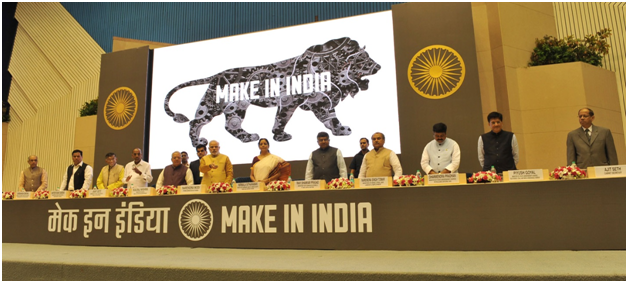Transforming Trends In India: How 'Make in India' is Fueling a Manufacturing Revolution Via Loan Services & Subsidies
"Make in India" is a visionary initiative that underscores India's commitment to becoming a manufacturing powerhouse on the global stage.
- By offering incentives such as loans, subsidies, and tax benefits, the initiative has created an attractive environment for manufacturers, both domestic and international, to invest in India.As "Make in India" continues to evolve and adapt to changing economic dynamics,
Make in India, Government, Manufacturing
Transforming Trends In India: How 'Make in India' is Fueling a Manufacturing Revolution Via Loan Services & Subsidies
Make in India: Boosting Domestic Production and Economic Growth
Overview:
"Make in India" is a transformative government initiative that aims to propel India into the league of global manufacturing powerhouses. Launched in September 2014 by Prime Minister Narendra Modi, this campaign seeks to create a conducive environment for domestic and international companies to manufacture their products within India. At its core, "Make in India" is about fostering innovation, investment, and industrialization while driving economic growth. In this article, we will explore the key aspects of the "Make in India" initiative, focusing on the incentives, including loans and subsidies, that are driving domestic production and boosting the country's economic prospects.
The Genesis of "Make in India":
- "Make in India" was launched with the vision of transforming India into a global manufacturing hub. The initiative was a response to the need for diversifying India's economy, reducing unemployment, and attracting foreign investment.
- The campaign aimed to showcase India's potential as a destination for high-quality manufacturing, highlighting its skilled workforce, vast market, and investor-friendly policies.
Incentives to Encourage Manufacturing:
One of the cornerstone principles of "Make in India" is the provision of various incentives, including loans and subsidies, to encourage domestic and international companies to establish or expand their manufacturing operations in India.
Access to Finance:
- "Make in India" has facilitated easier access to finance for manufacturing projects. The government, in collaboration with financial institutions, offers loans at competitive interest rates to eligible manufacturers.
- These loans help businesses acquire the capital they need for setting up new manufacturing units, upgrading technology, and expanding existing operations.
Subsidies and Tax Benefits:
- The initiative provides subsidies and tax benefits to reduce the overall cost of manufacturing in India. This includes reduced customs and excise duties, making raw materials and equipment more affordable for manufacturers.
- Special Economic Zones (SEZs) established under "Make in India" offer various tax exemptions and benefits to promote manufacturing within these zones.
Infrastructure Development:
- To facilitate manufacturing activities, "Make in India" focuses on infrastructure development. Improved roads, ports, and logistics networks reduce transportation costs and enable the smooth movement of goods.
- Special industrial corridors and parks have been planned to create dedicated manufacturing zones with world-class infrastructure.
Ease of Doing Business:
The government has embarked on a series of reforms to improve the ease of doing business in India. Streamlined regulations, a digitalized approval process, and reduced bureaucratic hurdles make it more convenient for manufacturers to operate.
Investment Promotion:
- "Make in India" actively promotes India as an attractive investment destination for manufacturers. The government organizes trade missions, investor summits, and promotional events to attract foreign direct investment (FDI).
- The campaign has resulted in several multinational corporations (MNCs) establishing or expanding their manufacturing operations in India.
Sectoral Focus:
- "Make in India" identifies key sectors with significant potential for growth and development. These sectors include automotive, electronics, textiles, pharmaceuticals, and defense production.
- Sector-specific policies and incentives are designed to cater to the unique requirements of each industry.
Job Creation:
The manufacturing sector has the potential to create millions of jobs in India. "Make in India" aims to capitalize on this opportunity by generating employment opportunities across various skill levels.
Global Success Stories:
- The initiative has witnessed numerous success stories, with companies from around the world choosing India as their manufacturing base. This includes major automotive manufacturers, electronics giants, and pharmaceutical companies.
- These success stories not only contribute to economic growth but also serve as examples of India's manufacturing capabilities to the global community.
Challenges and Future Prospects:
- Despite its successes, "Make in India" faces challenges such as infrastructure bottlenecks, regulatory complexities, and global competition.
- The future of the initiative lies in addressing these challenges, expanding its reach to smaller enterprises, and fostering innovation and research in manufacturing.
End of Conclusion:
- "Make in India" is a visionary initiative that underscores India's commitment to becoming a manufacturing powerhouse on the global stage.
- By offering incentives such as loans, subsidies, and tax benefits, the initiative has created an attractive environment for manufacturers, both domestic and international, to invest in India.
- As "Make in India" continues to evolve and adapt to changing economic dynamics, it holds the promise of driving substantial economic growth, creating jobs, and positioning India as a manufacturing leader in the 21st century.
Writer
Devraj Gorai


























